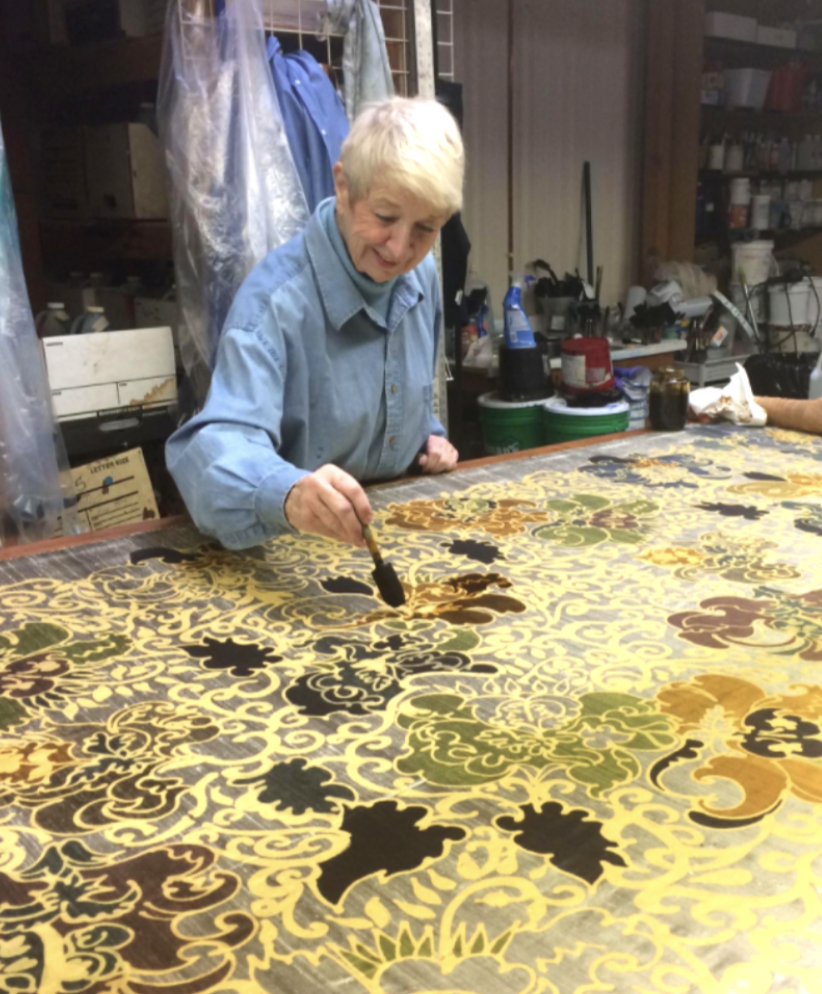Heather Kearsley Wolf spent more than three years cataloging the remaining works of the late Barbara Beckmann, the pioneering fabric designer whose work hangs in the White House and embassies and luxury hotels around the world. Through hard work and perseverance, she finally had the hundreds of bolts organized, priced and ready to sell. Ten days later, the building she was storing it all in burned to the ground.
It’s been over a month since the fire, and Kearsley Wolf, a Bay Area–based interior designer and the founder of bespoke linen company Kearsley, has had time to process the whole ordeal. While the loss of Beckmann’s final designs (“works of art, really,” she says) is devastating, she is grateful for the opportunity to speak more about the fabric designer’s legacy.
Though only a trace of her work remains, Beckmann, who died of cancer in 2018, had an outsize influence that still ripples through the fabric industry. “She was somebody that we shouldn’t forget, because the depth of her textile oeuvre is astounding—she did screen printing, block printing and hand painting,” says Kearsley Wolf. “There was so much artistry that went into these masterpieces. Her work was magical, and so was she.”

Beckmann was born in Chicago in 1939 and moved to New York after getting a degree in fine art from the University of Illinois, hoping to make it as a painter. When she was just 22, her art was featured in a showcase at the Brooklyn Museum alongside works by Richard Avedon and Elaine de Kooning. The life of a painter didn’t suit her, however, and she instead pursued a career in corporate textile design. In 1974, she and her husband, the late Jon Beckmann, relocated to San Francisco, where she began to develop her hand-painted textiles, quickly amassing a dedicated trade clientele. Her extravagant fabrics have draped windows in the White House and Middle Eastern palaces, in addition to winning her a devoted following in the hospitality sector, with her work adorning hotels such as the Lotte New York Palace, the Four Seasons, and Wynn Resorts.
Kearsley Wolf was first introduced to Beckmann’s textiles in 1994, while working at a Los Angeles design firm. “I became enamored with her fabrics,” she recalls. The two met a few years later, when she moved back to her native Sonoma, where Beckmann had also settled. They became fast friends and frequent collaborators. The designer—who had launched her own firm by then—often used Beckmann’s fabrics in her work and would ultimately become one of her final clients. “She was so fun to work with—just endlessly curious and always trying something new—a new technique, a new material. She was incredible.”
After Beckmann passed away, Kearsley Wolf worked to help the textile designer’s sister, Beth Buhler, sell the naming rights and designs, connecting her with a fabric manufacturer in the United Kingdom. However, the deal fell apart during the uncertainties of 2020. Buhler said that her sister’s company was “a mess” and largely penniless, so she couldn’t offer Kearsley Wolf any compensation for the time she had put in, but told her she could have Beckmann’s remaining inventory and sell it.
“There were rolls and rolls of mystery fabrics,” says Kearsley Wolf. It ended up being over 800 bolts, about 300 of which were donated to local textile arts and theater programs. “In true Barbara fashion, maybe 27 of them were labeled—we had to pull them out one by one. Some of them were four different fabrics rolled all together.” On January 15, she finally uploaded the last remnants and bolts onto Beckmann’s website.
The cataloging effort, which the designer undertook while running her own business, lasted several years. A friend who had previously worked on inventory management for Gap helped her build what she calls “a monster spreadsheet” to keep track of everything. Throughout the process, the fabric was insured and moved among various storage facilities of friends or acquaintances who offered to house the massive inventory for free or reduced rates. Most recently, that led to a friend’s closed commercial property in Sonoma. Because the building was vacant, it was uninsurable, which meant Kearsley Wolf wasn’t able to keep the fabric insured either. “But there was no one in the building, it was locked up—I thought, ‘It will be fine,’” she says. They moved the fabric from a storeroom in nearby Marin County to the Sonoma property in September. On the morning of January 28, ten days after everything was finally catalogued, the building caught on fire.
Fire inspectors discovered evidence that someone had been living in the building after the fabric was moved in. “A couch had been moved in that hadn’t been there when we’d locked the fabric up,” says Kearsley Wolf. “They told us we could come search through the ashes and see what we could save—there was nothing. It was all gone.” She estimates it was at least $200,000 in inventory. “I can make that money back in my own work, but that beautiful fabric is gone. And it was truly amazing.”
Of the hundreds of bolts once in her possession, only 80 pieces that Kearsley Wolf had at her own office survive—some of the last physical remnants of a legacy in fabric. Still, Beckmann’s influence and spirit live on. “You know, Barbara had a great sense of humor, and I just keep thinking to myself: ‘What’s the purpose of all this?’ What I’ve come up with is that this is Barbara looking down at me, glass of wine in hand, saying, ‘OK, enough! Focus on Kearsley. Focus on yourself! I’m getting rid of it. I’m getting it out of your way.’”





























